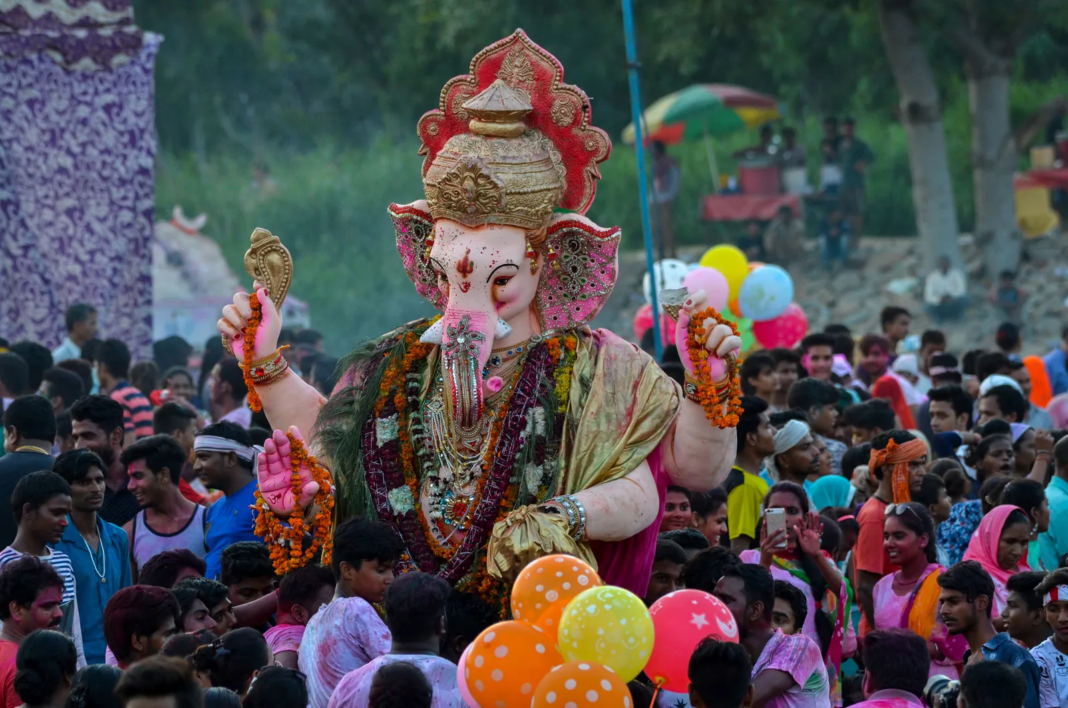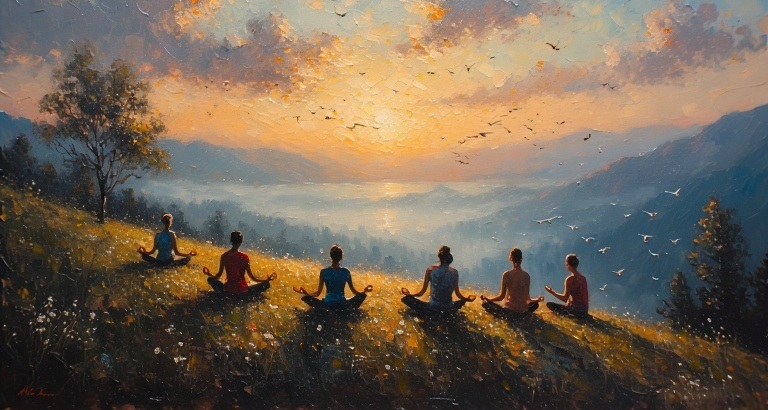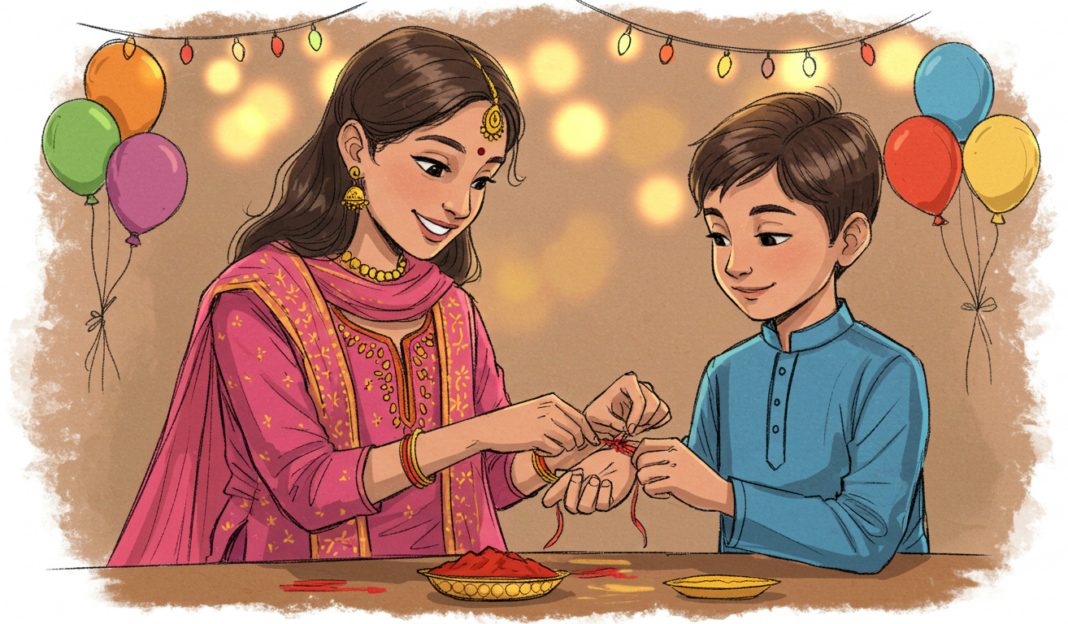॥ ॐ गं गणपतये नमः ॥
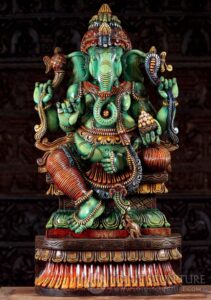
The upcoming GaNeshotsav occurs on GaNesh Chaturthi (also known as Vināyaka Chaturthi) on the fourth day after the new moon in the month of Bhādrapada in the year 2082 Vikram Samvat (that is 27 August 2025). The festival ends on Anantachaturdashi, the fourteenth day after the new moon (day before full moon) on 6 September 2025. It is believed by countless Hindus that on Vināyaka Chaturthi GaNesha was born or rather brought into being from clay by goddess Pārvati.
GaNesha or GaNapati is an iconic and beloved deity globally. But he is more than just another God among the thirty-three koti (types, not 33 crores/330 million) hindu devatas. Let us explore the cultural, social, & metaphysical significance of GaNesha.
GaNesha’s birth
The story goes that Pārvati was often alone in Mount Kailāsh as her husband Shiva was always roaming the world or deep in meditation. So longing for companionship she created a boy from sandalwood paste and clay, breathed life into him, and named him Vināyaka. She instructed him to guard the entrance to the house whilst she bathed, and to not let anyone inside. Shiva returns and he sees the boy adamantly blocking the door and preventing entry to his own abode, and neither recognise each other. Shiva gets enraged and in the battle that ensues he beheads the boy. Pārvati hears the commotion and comes out to see the headless body and is devastated. To appease Pārvati and as a repentance, Shiva promises to find a new head to the boy and instructs his gaNās (followers) to fetch the head of the first animal they come across. They come back with an elephant head and he attaches it to the body and the boy is brought back to life. Shiva declares the elephant headed boy as GaNesha/GaNapati (lord of gaNās), and blesses him to be known as the remover of obstacles and god of wisdom.
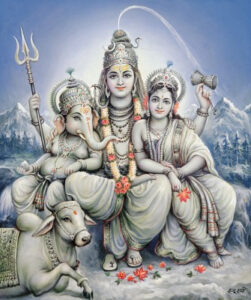
GaNesha festival – GaNeshotsav
It is not known when the celebration of GaNesha Chaturthi began, but one story is linked to the Mahabharata period, dated 5561BCE according to researcher Nilesh Oak (Oak, n.d.). On the request of Krishna Dvaipayan Vyās Rishi (Rishi Vyās) GaNesha agreed to write the whole story of Mahabharata. GaNesha asked Rishi Vyās to not stop dictating or he will stop writing. In return Rishi Vyās told GaNesha that he will only write down what is said once he has understood the meaning. Every time Vyās said something complex, GaNesha had to think and understand before writing it down. Thus the dictation went for 10-11 days. After completion Vyas noticed that GaNesha was burning and covered with ash, so in order to cool him he submerged him in water. This is why today Hindus immerse GaNesha’s murti (not “idol”) in water when he is farewelled after 10 days of celebrations.
While GaNesha is mentioned in the Vedas, it was during the puranic times when the deity gained popularity. According to Adi Shankaracharya, like the Shaiva, Vaishnava and Shākta tradition in India, there also was a GāNapatya tradition. In this branch of Hinduism, people knew God through Ganesha. After Chhatrapati Shivaji Maharaj, the Peshwas came to power in Maharashtra and carried the Maratha empire forward. They were mainly responsible for the popularity of GaNesha worship as their ishta-devatā. GaNeshotsav celebrations as a community event was restarted by great Indian freedom fighter Lokmānya Bāl Gangadhar TiLak in 1893 as a means to bring the people together against the oppressive British rule (India Today, n.d.).
Today in Bharat, GaNeshotsav is particularly popular in the states of Maharashtra and Telangana. In Maharashtra, GaNeshotsav is celebrated in different ways with some lasting for one and half days or up to ten days. People invite GaNesha to their homes and also the whole community participates in public GaNeshotsav with full pomp and glory. It is also often celebrated as Gauri-GaNapati to honour goddess Gauri (Pārvati) mother of GaNesha. It symbolises the arrival of prosperity, fertility, and marital bliss. According to tradition, Gauri is invited into homes on Bhadrapada Shashthi, 6th day after the new moon. Gauri’s murti is established next to GaNesha and decorated. Women, especially married ones, dress beautifully, perform ārti, sing devotional songs, pray for their family’s well-being, and prepare delicious food. The festival culminates with the immersion of Gauri-GaNapati murtis in water (pond, well, river, or sea) with prayers and songs symbolising their return to Mount Kailāsha.
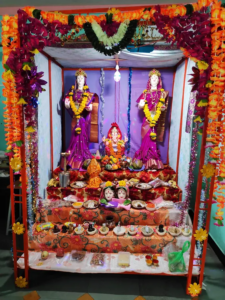
Ganesha: science and spiritual significance
The form of GaNesha has much intricate symbolism behind its various aspects.
The Elephant Head
It symbolises joy, strength, intelligence and memory, gentleness and majesty
The Big Belly
It is identified with storage of food, but more importantly associated with his forgiveness of our misdeeds since he accepts us wholly
The Large Ears
Signifies the importance of listening and sound. GaNesha is associated with four forms of sound – parA, pashyanti, madhyamA, and vaikhari. They represent different levels of the stages of sound, parA: the formless thought (subconscious), pashyanti the thought (mind), madhyamA: the processed thought (intelligence), and vaikhari: the spoken word (speech). Each level is a different level of consciousness and are all interconnected. The journey from parA to Vaikhari mirrors the process of creation — from the formless, unmanifested potentiality to the tangible, manifested reality.
Two tusks, one broken
Represents the idea that life always comes in opposites such as wins and losses, joy and suffering. One should remain steady in their journey regardless of the situation.
The Mouse symbolism
GaNesha’s vāhana or vehicle is a tiny mouse. The mouse represents the constantly active nibbling thoughts and experiences in our conscious mind whereas the elephant represents the subconscious storehouse of memories.
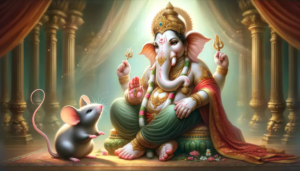
GaNesha and the moolAdhAra Chakra
Inside the human organism are the three naDis which are called iDa, pingaLa and sushumna. These three primary energy channels (naDis) in yogic and tantric traditions, are not physical structures, but rather subtle pathways for the flow of prāna (life force). The lowest end of the sushumna naDi where both the iDa and pingaLa are joined together is known as the mulAdhAra. mulAdhAra (moola AdhAram) is the root foundation on which the rest of the human organism is built up and responsible for grounding and stability. It is located at the base of the spine and serves as the resting place of Kundalini energy, which lies dormant until awakened for spiritual progression. From the mulAdhAra to the Sahasrāra, there are 7 centers of the ascent of consciousness from the grossest till it reaches the subtlest level. And each represents a level of consciousness which is finer than the other. MulAdhAra, the grossest and that which is related to the Earth, is therefore represented by the Prakriti-tattva and symbolized by GaNesha. Without a balanced and activated mulAdhAra, we cannot advance spiritually. GaNesha helps remove the blockages (physical, mental, or emotional) that hinder the flow of energy, enabling us to ascend through the higher chakras and towards liberation (moksha/mukti). Thus GaNesha is also known as Vighneshwara, Vighnahartā – the remover of all obstacles.
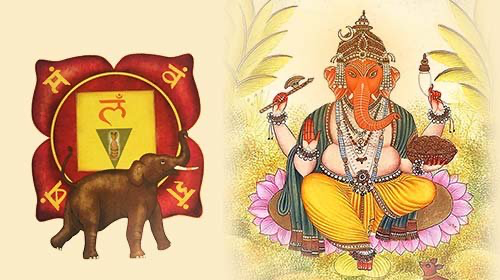
Although typically GaNesha is invoked with a form, shape, and a symbol, the scriptures refer to GaNesha in the GaNesha Stavam as:
अजं निर्विकल्पं निराकारमेकम् निरानन्दं आनन्दं अद्वैतपूर्णम्।
परम् निर्गुणं निर्विशेषं निरीहं परब्रह्मरूपं गणेशं भजेम॥
ajaṃ nirvikalpaṃ nirākāramekam nirānandaṃ ānandaṃ advaitapūrṇam ।
param nirguṇaṃ nirviśeṣaṃ nirīhaṃ parabrahmarūpaṃ gaṇeśaṃ bhajema ॥
Here GaNesha is recognized as nirvikalpaṃ the one without any definition, or impurities, nirākāramekam which means the one without form. He is also described as ānandaṃ, advaitam and pũrnam which actually are the descriptions of the Supreme Brahman. In Parabrahmaroopam, GaNesha is being symbolized as a manifestation of that Parabrahma. So when you bow down to Ganesha, you are bowing down to the Parabrahman, the Supreme.
Stotrās and mantrās for GaNeshārādhanā (Stotrās of Sri GaNesha, n.d.)
Shlokās:
- Agajānana Padmarkam – अगजानन पद्मार्कं गजाननं अहर्निशम्
- Gajānanam Bhutaganadi Sevitam – गजाननं भूतगणादि सेवितं
- Mushika Vāhana Modaka Hasta – मूषिकवाहन मोदकहस्त चामरकर्ण विलम्बितसूत्र
- Shuklāmbaradharam Vishnum – शुक्लाम्बरधरं विष्णुं शशिवर्णं चतुर्भुजम्
- Vakratunda Mahākāya – वक्रतुण्ड महाकाय सूर्यकोटि समप्रभ
Stotrās:
- GaNesha Panchāratnam (Ādi Shankarāchārya) – मुदाकरात्तमोदकं सदा विमुक्तिसाधकं
- Sankata Nāshana Stotrā (Nārada PurāNa) – प्रणम्य शिरसा देवं गौरीपुत्र विनायकम्
Vedic Mantrās:
- GaNānām Tvā GaNapatim (Rig Veda 2.23.1) – गणानां त्वा गणपतिं हवामहे
- GaNapati Atharvashiirsha (Ganapati Upanishad) – ॐ नमस्ते गणपतये
Pilgrimage Shlokās:
- Ashtavināyaka – स्वस्ति श्रीगणनायकं गजमुखं मोरेश्वरं सिद्धिदम्
Nāma Japa::
- GaNesha Gāyatri Mantra – ॐ एकदन्ताय विद्महे वक्रतुण्डाय धीमहि
GaNesha across various countries
Ancient Ganesha temples exist in countries like Mexico, Cambodia, Sri Lanka, Thailand, Indonesia, China, Japan and Iran. (Subramuniyaswami, n.d.)
| 1. Indonesia | 2. Afghanistan | |
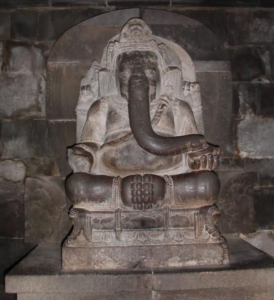 |
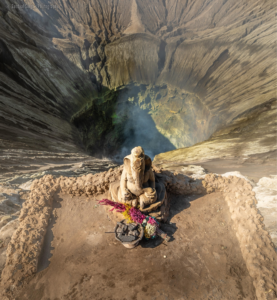 |
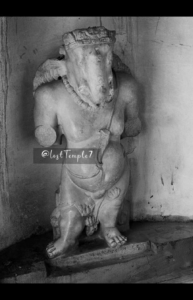 |
| Thailand | 4. Japan | 5. Tibet |
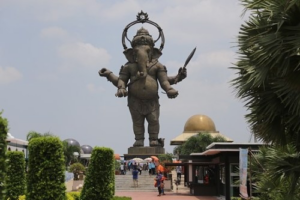 |
 |
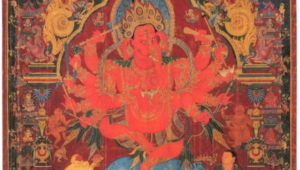 |
6. GaNesha beyond India
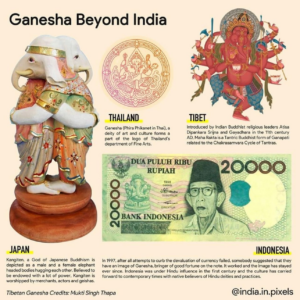
(India In Pixels, n.d.) |
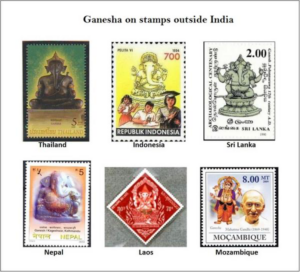
(S, n.d.) |
GaNeshotsav in Australia
GaNeshotsav in Australian community temples have evolved significantly over the past several decades. The tradition began with small gatherings in devotees’ homes, eventually moving into purpose-built temples and large community centers, becoming important cultural and religious events for the Hindu diaspora. Celebrations now often feature pujas, clay idol making, music, classical dance, community meals (annadānams), and children’s performances.
Key developments in the history of Ganeshotsav in Australia include:
- The Hindu Society of South Australia, established in the 1970s, built the Shri GaNesha Temple, Adelaide’s first traditional Hindu temple (ASGS Inc, n.d.)
- In Melbourne, the Melbourne Vinayāgar Hindu Sangam (MVHS) temple’s first major Mahotsavam (festival) took place in 2008 (MVHS, n.d.)
- The Sri Venkateswara Temple in Helensburgh, NSW hosts one of the most prominent GaNeshotsav celebrations in Australia going back to the late 1990s (indianlink, 2023)
- Brisbane’s Sri Selva Vināyakar Koyil (SSVK), its South Maclean GaNesha Temple, attracts not just Hindus but all Australians (SVKBrisbane, n.d.)
- The most recent GaNehsotsav was started in Sunshine Coast in 2023 (Aditya Utsav Mandal, n.d.)
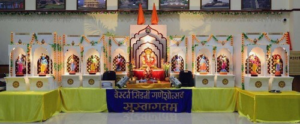 |
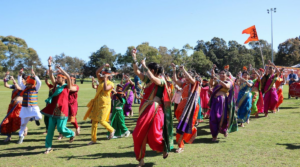 |
Let GaNesha guide us through our journey in life and enable us to overcome all obstacles towards an all encompassing empathetic peaceful world to live in.
॥ गणपति बाप्पा मोरया ॥
॥ मंगल मूर्ति मोरया ॥
References
- Aditya Utsav Mandal. (n.d.). https://www.facebook.com/aditya.utsav.mandal/
- ASGS Inc. (n.d.). https://www.asgs.org.au/about/history/
- India In Pixels. (n.d.). https://x.com/indiainpixels/status/1704049014344450284
- indianlink. (2023, September 28). Ganesh Festival in Sydney: how the city celebrated this year. Indian Link. Retrieved July 30, 2025, from https://www.indianlink.com.au/ganesh-chaturthi-festival-in-sydney-2023/
- India Today. (n.d.). https://www.indiatoday.in/education-today/gk-current-affairs/story/bal-gangadhar-tilak-transformed-ganesh-chaturthi-movement-against-british-2600618-2024-09-16
- melbourneganeshotsav. (n.d.). https://www.melbourneganeshutsav.com/
- MVHS. (n.d.). Sri Vakrathunda Vinayagar Temple. Retrieved July 30, 2025, from https://www.mvhs.org.au/
- Oak, N. N. (n.d.). https://nileshoak.wordpress.com/2018/09/07/on-the-chronology-of-mahabharata-war-5561-bce-vs-3067-bce-part-1/
- S, V. (n.d.). https://x.com/SchoolVedic/status/506829240658972672
- Stotras of Sri Ganesha. (n.d.). Green Message. Retrieved July 30, 2025, from https://greenmesg.org/stotras/ganesha/
- Subramuniyaswami, S. S. (n.d.). Ganesha in world religions – Wikipedia. Retrieved July 30, 2025, from https://en.wikipedia.org/wiki/Ganesha_in_world_religions
- SVKBrisbane. (n.d.). _/|\_ Sri Selva Vinayakar Temple, Brisbane, Queensland,Australia _/|\_. Retrieved July 30, 2025, from http://sriselvavinayakar.org/


